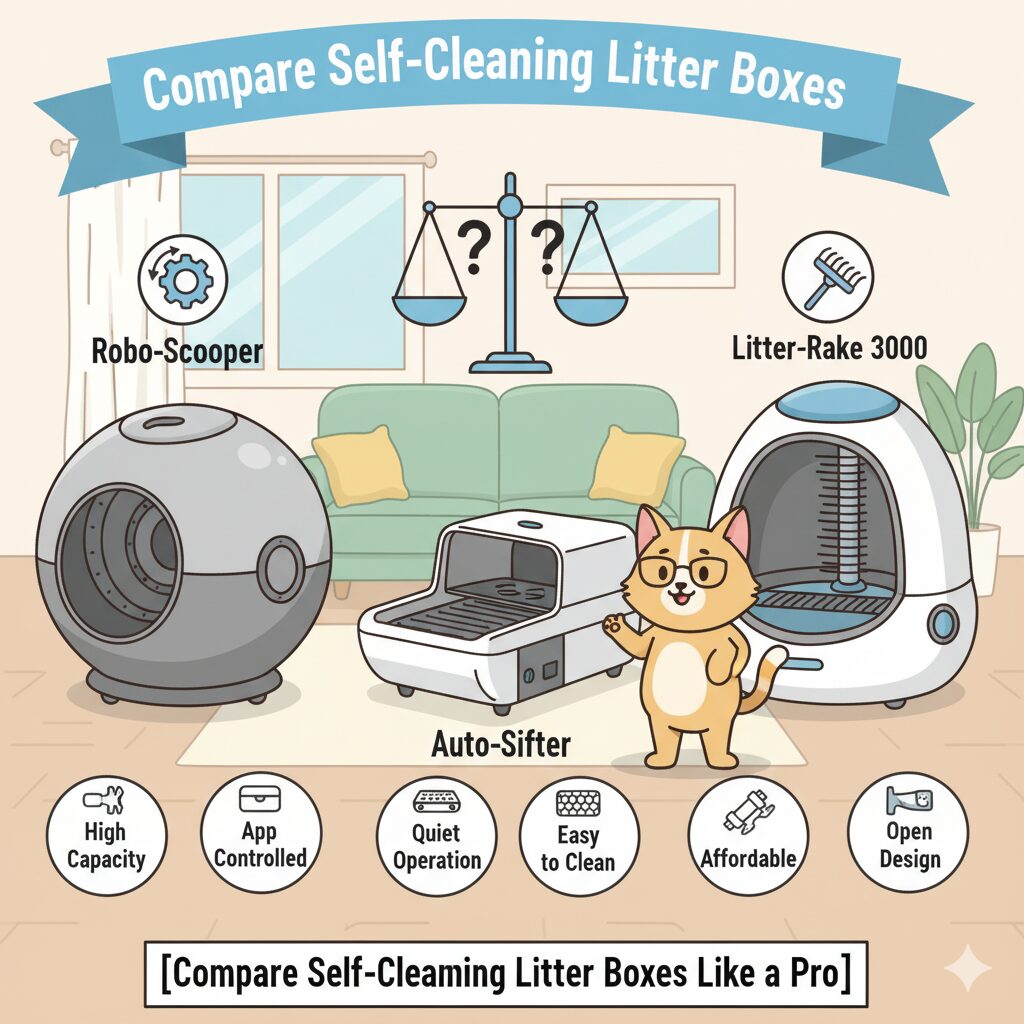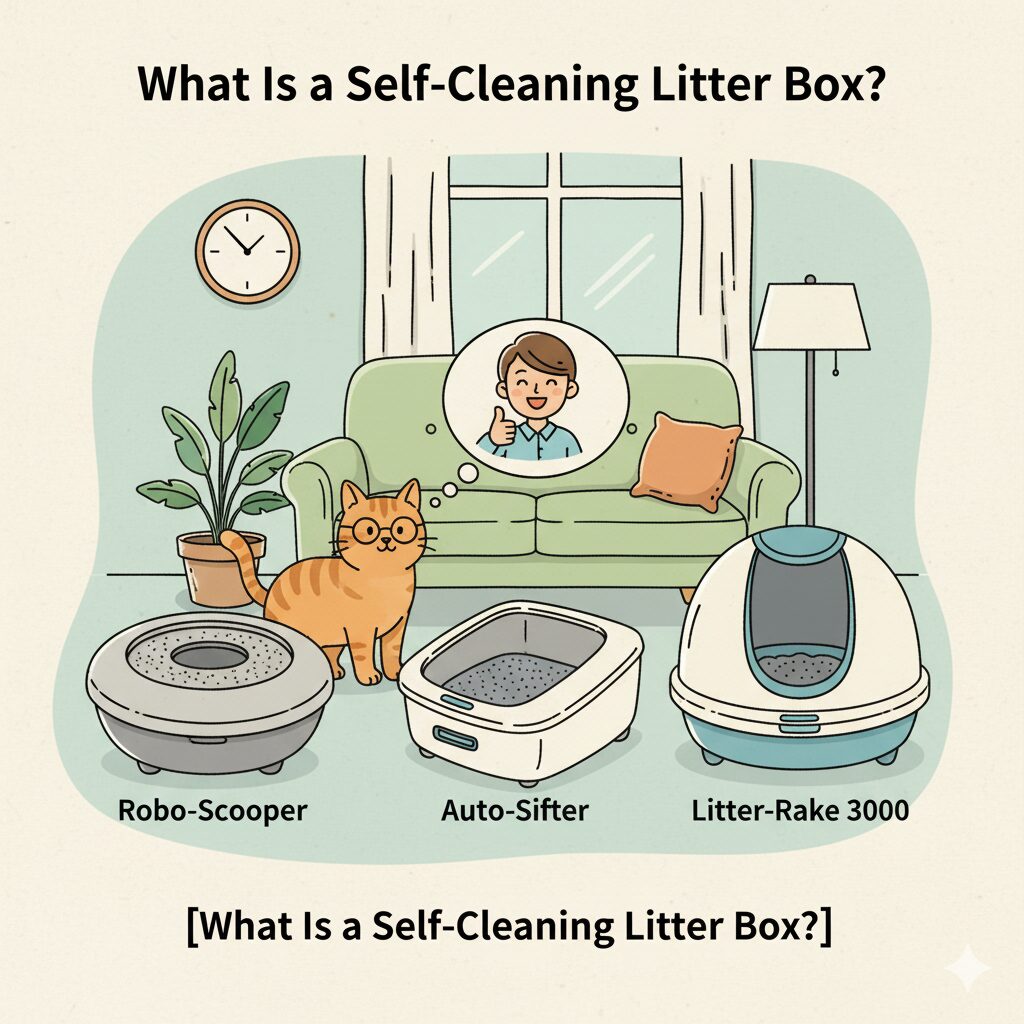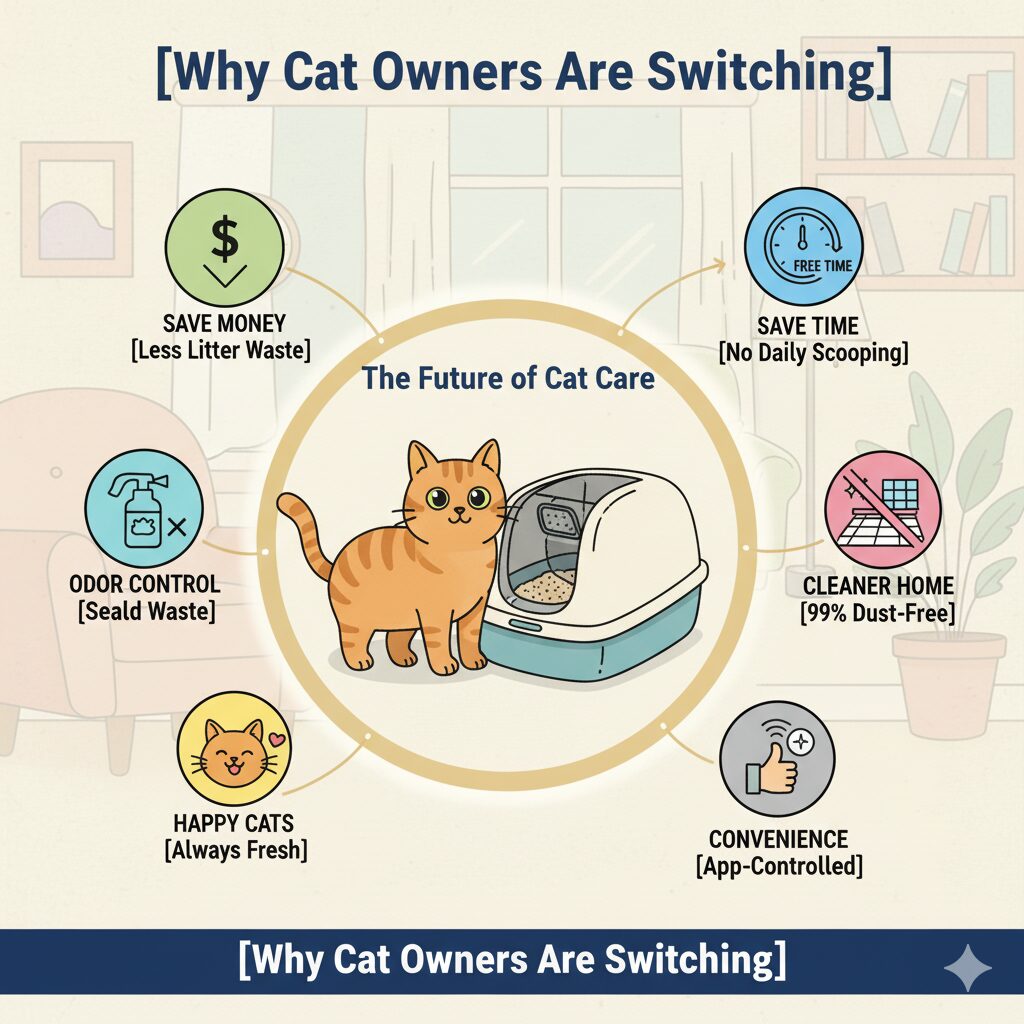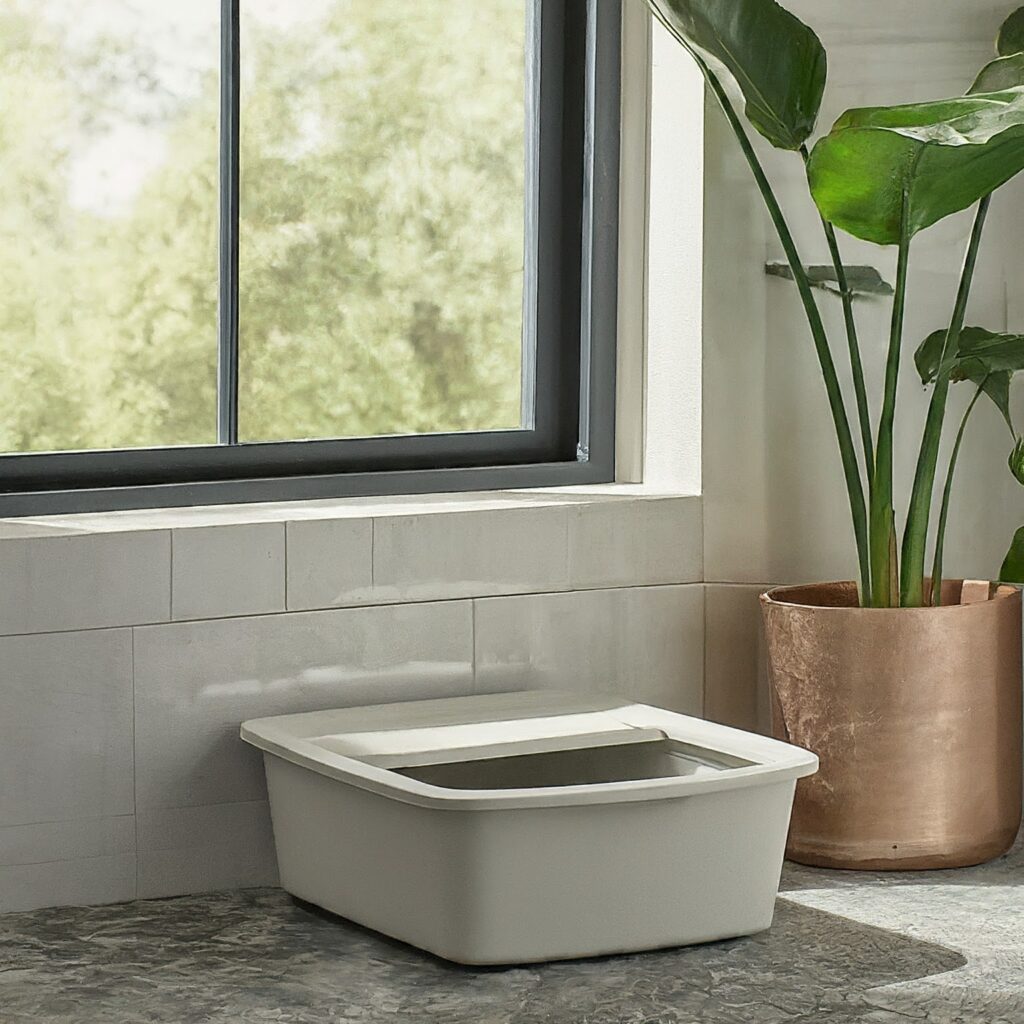
Why You Must Compare Self-Cleaning Litter Boxes Before Buying
In 2025, automatic litter boxes have become one of the hottest cat care trends. Searches for “automatic cat litter box” and “self-cleaning litter box” peaked mid, as cat parents look for cleaner, smarter, and odour-free homes.
But here’s the truth: not all self-cleaning litter boxes deliver what they promise. Some save time, but stress out your cat. Others look futuristic but burn through electricity or fail after a few months.
That’s why it’s vital to compare self-cleaning litter boxes — not just by price, but by safety, comfort, maintenance, eco-friendliness, and multi-cat performance.
By the end of this guide, you’ll know exactly:
- Which models work best for your cat type
- When to upgrade (and when not to)
- How to balance price vs. long-term value
- What litter types work with each model
Let’s dive into the 7 smart comparisons that make or break your choice.
I write with love and care, keeping your furry friend’s health first and following the doctor’s guidance. If it helps, share it—because health and knowledge grow stronger when we share them within our community. My words are carved in stone — I truly worship my cat. Everything I share with you here comes straight from my cat’s own wisdom. That’s why I encourage you to share this blog as much as possible! Also, let me tell you — this is a top-quality blog, so make sure to read it completely to get the most benefit and keep your cats happy and healthy. A cat is the light that brightens every home.
Table of Contents
What Is a Self-Cleaning Litter Box?

Before we compare self-cleaning litter boxes, let’s first understand what they actually are — and why they’re becoming a must-have in modern cat homes.
A self-cleaning litter box is an automatic waste management system designed to save cat owners time, effort, and the daily hassle of scooping. Unlike traditional litter boxes, these devices use sensors, motors, and smart technology to detect when your cat has finished using the box — then rake, sift, or flush away the waste into a sealed compartment.
Essentially, it’s like having a mini robot janitor for your cat’s bathroom. The goal? Keep your home odour-free, reduce litter tracking, and make maintenance easier than ever.
Here’s what makes self-cleaning litter boxes stand out:
- Automatic Cleaning Cycle: The box senses when your cat exits and cleans itself — no scooping needed.
- Odour Control System: Many models include carbon filters, odour-sealing lids, or smart deodorising units to keep smells under control.
- Smart Features: High-end versions connect to your smartphone, letting you track your cat’s litter habits, waste levels, and cleaning cycles.
- The Pros & Cons of a Self-Cleaning Litter Box: These systems often use less litter than traditional ones, saving you money over time.
- Health Monitoring: Some advanced models even monitor urination frequency or litter box visits, giving early warnings for health issues like UTIs.
In 2025, more cat parents are choosing automation not just for convenience, but also for their cat’s comfort and hygiene. By understanding how these litter boxes work, you can make smarter buying choices when you compare self-cleaning litter boxes side by side.
Why Cat Owners Are Switching

In 2025, more cat parents are opting for self-cleaning litter boxes than ever before. The trend is driven by busy lifestyles, urban living, and the increasing availability of smart pet care devices. Searches for terms like “automatic litter box vs manual” or “best robotic litter tray” have surged, reflecting a growing desire for convenience without compromising cat hygiene.
One of the main reasons owners are upgrading is time-saving automation. Traditional litter boxes require daily scooping, which can be messy and unpleasant. In contrast, a self-cleaning litter box automatically removes waste, leaving clean litter behind, which reduces odour and frees up time for pet parents. This feature alone answers the common query: Are self-cleaning litter boxes good? The short answer: yes, especially for busy households or those with multiple cats.
Another factor driving the switch is improved cat health monitoring. Modern automatic litter boxes track your cat’s usage, providing insights into urination frequency and litter habits — early indicators of potential health issues like UTIs or digestive problems. These insights are not possible with standard manual litter trays.
Cat comfort also plays a role. Advanced models are designed to be quiet, spacious, and low-stress, reducing anxiety for skittish cats while ensuring consistent use. Eco-conscious consumers are also noticing the benefits, as self-cleaning litter boxes often reduce litter consumption and use energy-efficient cleaning mechanisms, making them a sustainable alternative to traditional boxes.
Finally, technological advancements and the rise of smart home integration mean these devices are easier than ever to set up and manage. With app notifications, automated cleaning cycles, and remote monitoring, cat owners are empowered to maintain hygiene effortlessly.
In short, when you compare self-cleaning litter boxes, the combination of convenience, health monitoring, cat comfort, and eco-friendliness explains why so many cat parents are making the switch in 2025.
How We Compare: The Framework You Can Trust
When you set out to compare self-cleaning litter boxes, it’s easy to get overwhelmed by features, prices, and brand claims. That’s why having a clear framework is essential. Our goal is to help you make informed decisions based on real-world performance, not just flashy marketing.
We evaluate self-cleaning litter boxes across seven key categories, so you can see which model fits your lifestyle, your cat’s needs, and your budget. Here’s the breakdown:
- 1. Price vs. Value: How much you pay versus what you actually get. Includes long-term savings on litter consumption, maintenance costs, and time saved.
- 2. Odour Control Efficiency: How well the box manages smell using carbon filters, sealed waste compartments, or automatic deodorising systems.
- 3. Cleaning & Maintenance Ease: How simple it is to empty waste drawers, replace filters, and clean the litter tray. Focus on units that minimise hands-on effort.
- 4. Cat Comfort & Adaptability: Noise levels, interior size, and entry height. A quiet, spacious, low-stress environment encourages consistent use.
- 5. Health & Monitoring Features: Ability to track litter habits, urination frequency, or weight changes — providing early warning signs of illness.
- 6. Eco & Sustainability Factors: Energy efficiency, reduced litter waste, and compatibility with biodegradable or tofu-based litter.
- 7. Multi-Cat Suitability: Performance in households with multiple cats, including fast cleaning cycles and larger waste capacity.
Each category is rated based on real-world testing, user feedback, and durability. This way, you don’t just see specs — you see how automatic litter boxes perform day-to-day.
Why this framework works:
- Provides a structured, side-by-side comparison
- Highlights both pros and cons clearly
- Helps you weigh features against your cat’s behaviour and your lifestyle
- Makes it easy to shortlist models without second-guessing
When you compare self-cleaning litter boxes using this framework, you get a holistic view — from cost-effectiveness and odour management to eco-friendliness and multi-cat performance. It ensures you pick a model that truly fits your needs and keeps your cat happy.
Price vs. Value: Does Paying More Really Pay Off?
When you compare self-cleaning litter boxes, price is often the first thing cat parents look at — and understandably so. These products can range anywhere from $100 to over $700, depending on their features, automation level, and brand reputation. But here’s the real question: Does paying more actually mean you’re getting more value?
Let’s break it down in a way that makes sense for every cat owner — whether you’re on a tight budget or ready to invest in a premium setup.
Understanding What You’re Paying For
A cheaper self-cleaning litter box (usually around $100–$200) will often cover the basics — automatic waste raking, simple sensors, and standard odour control. However, it may lack advanced motion detection, quiet operation, or smartphone monitoring features. Over time, these missing features can mean more maintenance for you and less comfort for your cat.
Mid-range models (in the $250–$400 range) tend to balance performance and convenience. They often include carbon filters, timed cleaning cycles, and clumping litter compatibility. These give better overall odour management, fewer manual cleanups, and a longer lifespan for both the device and your litter boxes.
On the higher end, premium self-cleaning litter boxes like Litter-Robot 4 or Whisker’s smart systems can cost $600–$700, but they often provide Wi-Fi tracking, app notifications, multiple-cat sensors, and advanced waste drawer sealing. For cat owners managing multiple cats, this investment often pays off in long-term hygiene, health monitoring, and convenience.
Initial Cost vs. Long-Term Savings
One of the most overlooked aspects when people compare self-cleaning litter boxes is the cost of ownership. Sure, the upfront price tag can sting, but think long-term. A high-quality self-cleaning litter box can reduce your litter usage by up to 50%, since it removes only the waste, leaving clean litter behind. That translates to fewer frequent refills and fewer purchases of cat litter bags every month.
In contrast, cheaper models may malfunction sooner or fail to detect waste properly, leading to more litter waste, frequent breakdowns, or even odour buildup that forces early replacement. Over a 2–3 year period, the premium model often costs less when you factor in fewer maintenance costs, less manual cleaning, and reduced odour issues.
Convenience Has a Price — But Also a Value
If you’ve ever scooped a litter box after a long day, you know the true value of convenience. With automatic self-cleaning litter boxes, the biggest benefit isn’t just cleanliness — it’s time.
Some users report saving 30–45 minutes per week in manual cleaning time. Over a year, that’s nearly 40 hours saved — the equivalent of a full workweek! That alone can justify the cost for busy pet parents, elderly owners, or people with limited mobility.
Also, smart litter boxes with Wi-Fi connectivity send real-time alerts about cleaning cycles or full waste drawers. This means no more guessing games or unpleasant surprises when you walk in. In 2025, more cat owners are prioritising smart automation, odour reduction systems, and health tracking, making convenience just as valuable as cost.
Durability and Warranty: The Hidden Value
When you compare self-cleaning litter boxes, don’t just look at features — check the warranty and build quality too. Premium brands often offer 12–24 month warranties, along with responsive customer support and easy access to spare parts.
Cheaper alternatives may lack long-term durability, and their motors or sensors may fail after a few months. That’s where investing a little more upfront can save you from frustrating replacements and additional shipping costs.
Durability also impacts your cat’s comfort. A sturdy litter box feels stable, reduces vibrations, and keeps your cat stress-free during automatic cleaning — an important detail that many buyers overlook.
So, Does Paying More Really Pay Off?
Yes — but only if you choose wisely. A higher price tag alone doesn’t guarantee satisfaction. The true value lies in the balance between technology, comfort, reliability, and maintenance savings.
If you’re someone who:
- Travels frequently,
- Has multiple cats,
- Or prefers hands-free maintenance —
Then a premium self-cleaning litter box is absolutely worth it.
However, if you live alone with one cat and don’t mind scooping occasionally, a reliable mid-range model could deliver the same cleanliness at half the cost.
Ultimately, when you compare self-cleaning litter boxes, remember this golden rule: value isn’t just what you pay — it’s what you keep using happily for years later.
Who Actually Keeps Your Home Smelling Fresh?
One of the most critical factors cat owners consider when they compare self-cleaning litter boxes is odour control. No matter how convenient a box is, if it doesn’t manage smell effectively, it can defeat the purpose of going automatic. Fortunately, modern self-cleaning litter boxes are engineered to tackle odours with advanced features that traditional litter boxes simply cannot match.
The secret to effective odour control lies in timely waste removal combined with sealed compartments and high-quality filters. Most top-rated models feature activated carbon filters, airtight waste drawers, and even automatic deodorising units that neutralise smell instantly. Some premium robotic litter boxes also employ scent-neutralising pellets or UV sanitisation to maintain freshness.
Here’s what you should look for when assessing odour control:
- Sealed Waste Compartment: Prevents odours from escaping into your home and keeps flies or pests away.
- Activated Carbon or HEPA Filters: Trap ammonia and reduce strong litter smells effectively.
- Quick Cleaning Cycle: Some boxes start the cleaning cycle within minutes after your cat exits, keeping odours at bay continuously.
- Deodorising or UV Systems: Advanced models include natural deodorising inserts or UV sterilisers for extra freshness.
When you compare self-cleaning litter boxes, it’s important to consider real-world performance, not just manufacturer claims. For example, some units maintain a neutral scent for 3–5 days, even in multi-cat households, while cheaper models may require daily manual intervention.
Additionally, cat comfort plays a role in odour management. A quieter unit encourages your cat to use the box consistently, preventing accidents and lingering smells. Energy efficiency is another bonus: most modern automatic litter boxes use minimal power while still keeping odour under control.
Ultimately, if you want a clean, fresh-smelling home without daily scooping, prioritising odour control features is essential. When you compare self-cleaning litter boxes, this category often separates budget options from premium, high-performance units.
Cleaning & Maintenance: How Much Work Are You Really Saving?
When you compare self-cleaning litter boxes, one of the first questions many cat owners ask is: “Will I still need to scoop or clean?” The truth is, while automatic litter boxes drastically reduce daily effort, they don’t eliminate maintenance. Understanding what each model requires is essential for choosing the right unit for your lifestyle and your cat.
Modern robotic litter boxes are designed to minimise hands-on work, but key maintenance tasks remain: emptying the waste drawer, replacing filters, and occasionally washing the tray. How much effort is required depends on the cat count, litter type, and the model itself. Some premium units let you go a full week or more between full cleanings, while budget-friendly models may require more frequent attention.
Here’s a breakdown of what to consider when evaluating cleaning and maintenance:
- Waste Drawer Access: Check how easy it is to remove and empty the drawer. Smooth, detachable drawers save time.
- Filter Replacement: Many automatic litter boxes use carbon or HEPA filters that need periodic replacement (every 2–6 weeks).
- Tray Cleaning: Even self-cleaning units require periodic washing. Look for non-stick surfaces or dishwasher-safe trays.
- Litter Type Compatibility: Using the correct clumping, low-dust, or tofu litter ensures the mechanism doesn’t jam, reducing maintenance headaches.
- Frequency of Cleaning: Top-rated models reduce daily scooping to once a week or less, saving 20–45 minutes per week, depending on cat usage.
A practical tip for multi-cat households: choose a unit with a larger waste capacity and fast cleaning cycles to avoid overflow. Some models even include app notifications to alert you when the drawer is full, ensuring you never miss a maintenance window.
When you compare self-cleaning litter boxes, consider not just how often you need to clean, but how effortless each cleaning session is. The right model will save you significant time while keeping your home odour-free and your cats comfortable.
Cat Comfort & Adaptability: Will Your Cat Use It?
Even the most advanced self-cleaning litter boxes are useless if your cat refuses to use them. Comfort and adaptability are key factors when you compare self-cleaning litter boxes, as cats can be surprisingly picky about their bathroom habits. Stress, noise, or an awkward design can lead to accidents outside the litter box, negating the convenience of automation.
Here’s what to consider to ensure your cat feels comfortable and confident with a new automatic litter box:
- Noise Levels: Cats are sensitive to sound. Look for boxes that operate quietly, typically under 30 dB, to prevent your cat from being startled by the motor.
- Interior Size: Ensure the box is spacious enough for your cat to turn around comfortably. Large breeds or overweight cats need extra room.
- Entry Height & Accessibility: Low entry points are ideal for kittens, senior cats, or cats with mobility issues. High walls may discourage timid cats.
- Material & Texture: Smooth, non-stick surfaces are easier to clean and more comfortable for sensitive paws. Avoid rough or slippery materials.
- Adjustment Period: Gradually introduce your cat to the robotic litter box. Place it next to the old litter tray for a few days, and reward your cat with treats or praise for using it.
Additional considerations include location and privacy. Cats prefer quiet, low-traffic areas, away from food or water bowls. Avoid placing the automatic litter box in noisy or high-traffic zones, as this can lead to avoidance.
By paying attention to cat comfort, you ensure consistent usage, reduce stress, and maintain the hygiene benefits of a self-cleaning litter box. When you compare self-cleaning litter boxes, the right choice balances advanced features with your cat’s natural preferences and behaviour.
Health & Monitoring: Don’t Let Automation Hide Warning Signs
One of the biggest misconceptions when you compare self-cleaning litter boxes is that automation removes the need to monitor your cat’s health. While automatic litter boxes save time and reduce odour, they can also hide subtle changes in your cat’s bathroom habits — early warning signs of illnesses like urinary tract infections (UTIs), kidney issues, or digestive problems.
Here’s the reality: these boxes clean away waste quickly, so unless your unit has smart monitoring features, you may miss critical changes. That’s why health tracking should be a priority.
Key Health & Monitoring Features to Look For:
- Visit Tracking: Some robotic litter trays record how often your cat uses the box, giving insights into potential health issues.
- Weight Sensors: Advanced units detect changes in your cat’s weight or body pressure, alerting you to possible health concerns.
- Time Spent in Box: Excessive time in the litter box may indicate constipation or urinary problems.
- App Notifications: Smart litter boxes can send alerts to your phone for unusual behaviour or when the waste drawer is full.
- Integration With Vet Apps: Some models allow exporting data for vet consultations, giving professionals a clear picture of your cat’s habits.
Reader-Friendly Tip: Think of your self-cleaning litter box as a health assistant, not a replacement for observation. Check the waste manually at least once a week, especially if you have multiple cats, to ensure nothing abnormal goes unnoticed.
By prioritising health monitoring, you not only maximise the benefits of automatic litter boxes but also protect your cat from hidden issues. When you compare self-cleaning litter boxes, the ones with reliable tracking and alert systems offer both convenience and peace of mind — a true win-win for busy cat parents.
Litter Compatibility & Real Maintenance Facts
When you compare self-cleaning litter boxes, one factor often overlooked by buyers is litter compatibility. Not every automatic litter box works well with every type of litter, and using the wrong kind can lead to jams, ineffective cleaning, or even damage to the unit. Understanding what works — and what doesn’t — is essential for a smooth, stress-free experience.
Key Litter Compatibility Insights:
- Clumping Clay Litter: Most robotic litter trays work best with low-dust, clumping clay. It forms firm clumps for the rake mechanism to easily scoop. Avoid lightweight clay that crumbles too easily.
- Tofu or Corn-Based Litter: Eco-conscious cat parents often choose biodegradable litter like tofu or corn. Premium self-cleaning litter boxes support these options, but check the manufacturer’s guide to avoid clogging.
- Silica Crystal Litter: Some high-end models handle silica gel crystals, which absorb moisture and control odour efficiently. However, these crystals may not clump, so rake-style boxes may not work properly.
- Non-Clumping or Fine Dust Litter: Avoid ultra-fine or non-clumping litter, as it can coat sensors, jam mechanisms, and trigger frequent maintenance.
Real Maintenance Facts to Keep in Mind:
- Drawer Emptying Frequency: Even the best automatic litter boxes need periodic emptying. Single-cat homes might manage with once-a-week emptying, while multi-cat homes require more frequent attention.
- Tray Cleaning: Smooth, non-stick surfaces are easier to rinse and maintain. Some models have dishwasher-safe trays, which make deep cleaning simple and fast.
- Filter Replacement: Most self-cleaning units include carbon or HEPA filters. Replacing these every 2–6 weeks ensures odour control remains effective.
- Maintenance Time Savings: Despite automation, expect to spend roughly 5–10 minutes per week on maintenance for a single-cat household — far less than daily scooping with traditional litter boxes.
Pro Tip for Multi-Cat Homes: If you have two or more cats, choose a model with larger waste capacity and fast cleaning cycles, and consider a unit that allows you to monitor usage via app notifications.
By understanding both litter compatibility and real maintenance expectations, you’ll ensure that your self-cleaning litter box delivers the full convenience and hygiene benefits you expect. When you compare self-cleaning litter boxes, this section is where practical, real-world decisions can save you frustration, money, and time.
Vet-approved Products for you
Litter‑Robot 4
- Endorsed as a “vet-approved automatic litter box” by the manufacturer’s vet partners.
- Features strong odour control (sealed waste drawer + carbon filter), and smart health‑monitoring capabilities (weight/usage tracking) that support early detection of changes in your cat’s bathroom behaviour.
- Ideal for multiple cats, and built to high-quality standards — good choice if you’re looking for long‑term value.
PetSafe ScoopFree Crystal Pro Self‑Cleaning Litter Box
- From a well‑known pet products brand, supports the “self‑cleaning litter boxes” category and mentions vet‑recommendation for maintaining a clean environment.
- Uses crystal litter for enhanced odour control, which can be attractive in small homes or apartments where smell is a big concern.
- Good mid‑range option balancing convenience and cost.
Neakasa M1 Self‑Cleaning Litter Box
- Featured in tech review comparisons for 2025 of the best automatic litter boxes; emphasises monitoring, sensors and ease of use.
- Designed with weight sensors and safety features that appeal to vets and tech‑savvy cat owners.
- Suitable if you’re interested in smart features and health‑tracking.
Further Readings: You need to know
How to pick a puppy from a litter
Pidan Tofu Cat Litter the Best Litter Box
Why Is My Cat Peeing Outside the Litter Box?
15 FAQs to Help You Compare Self-Cleaning Litter Boxes
What is the best self-cleaning litter box to buy?
The best self-cleaning litter box depends on your cat’s size, the number of cats, and your budget. Top-rated options in 2025 include Litter-Robot 4, PetSafe ScoopFree Crystal Pro, and Neakasa M1, known for automatic cleaning, odour control, and multi-cat suitability. When you compare self-cleaning litter boxes, prioritise models with quiet operation, smart monitoring, and litter compatibility for a hassle-free experience.
How do self-cleaning litter boxes work?
Self-cleaning litter boxes use sensors, motors, or rakes to detect when a cat has finished using the box. The system automatically scoops or sifts waste into a sealed compartment, leaving clean litter behind. Advanced models include smart features like app notifications, health tracking, and odour control. Understanding these mechanics is essential when you compare self-cleaning litter boxes for performance and convenience.
Why should I compare self-cleaning litter boxes before buying?
Not all automatic litter boxes are created equal. Comparing options allows you to evaluate price vs. value, litter compatibility, noise levels, multi-cat performance, and maintenance requirements. This ensures you select a box that suits your cat’s habits while reducing odour and time spent cleaning. In 2025, side-by-side comparisons also highlight eco-friendly models that save litter and energy.
Who makes the most reliable self-cleaning litter boxes?
Brands like Litter-Robot, PetSafe, and Neakasa are widely recognised for producing reliable self-cleaning litter boxes. Vet-approved models from these brands focus on cat comfort, health monitoring, and long-term durability. When evaluating, check for user reviews, build quality, and maintenance support to ensure reliability.
When should I upgrade to a self-cleaning litter box?
Upgrade to a self-cleaning litter box if daily scooping is inconvenient, if you have multiple cats, or if you want better odour control. Signs that it’s time include frequent cat accidents, increasing litter dust, or limited time for cleaning. In 2025, owners also consider smart features, energy efficiency, and litter savings before upgrading.
Where can I find reviews for self-cleaning litter boxes?
You can find in-depth reviews for self-cleaning litter boxes on websites like Wirecutter, PetSafe official site, Litter-Robot website, Reddit forums, and Amazon. Look for reviews that discuss noise, maintenance, cat acceptance, and long-term performance to make an informed choice when you compare self-cleaning litter boxes.
What are the advantages of a self-cleaning litter box?
The key advantages include time-saving convenience, consistent odour control, reduced litter waste, and health monitoring features. Self-cleaning litter boxes help prevent urinary tract issues, reduce stress for cats, and are ideal for busy households. Comparing models ensures you choose one that aligns with your cat’s behaviour and your lifestyle.
How much do self-cleaning litter boxes cost?
Prices vary from $150 for basic models to over $500 for premium options. Costs include initial purchase, replacement carbon filters, and compatible litter types. When you compare self-cleaning litter boxes, consider long-term value, including time saved, reduced litter consumption, and maintenance needs.
Why are self-cleaning litter boxes better than manual ones?
Automatic litter boxes are better because they reduce daily scooping, maintain consistent hygiene, minimise odour, and track cat health indicators. While manual boxes require frequent cleaning, self-cleaning options save time, improve home cleanliness, and support multi-cat households efficiently.
Who benefits most from using a self-cleaning litter box?
Busy cat owners, households with multiple cats, and those with health or mobility challenges benefit most. Cats sensitive to stress or odor also benefit from quiet, self-cleaning litter boxes. When you compare self-cleaning litter boxes, select models with smart features, health monitoring, and cat comfort.
What litter types work best in self-cleaning litter boxes?
Low-dust, clumping clay litter works best for most robotic litter boxes, ensuring smooth scooping. Biodegradable litter, like tofu or corn-based, are compatible with premium models. Avoid fine dust or non-clumping litter, as it may jam mechanisms. Proper litter selection is crucial when you compare self-cleaning litter boxes.
When is the best time to introduce a self-cleaning litter box to your cat?
Introduce it gradually. Place the self-cleaning litter box next to your old box, and allow your cat to explore it without activating the rake. Gradually enable automatic cleaning cycles over 3–7 days. Timing and patience improve cat acceptance and prevent accidents.
How to maintain a self-cleaning litter box properly?
Regular maintenance ensures optimal performance:
Empty the waste drawer weekly or as indicated.
Replace carbon or HEPA filters every 2–6 weeks.
Wash tray surfaces with mild soap and water.
Use compatible litter types.
Proper maintenance keeps automatic litter boxes odour-free and prolongs their lifespan.
Wrap up: Make the Right Choice When You Compare Self-Cleaning Litter Boxes
Choosing the perfect self-cleaning litter box is more than just picking the most expensive or feature-packed model — it’s about balancing cat comfort, hygiene, maintenance ease, and long-term value. By understanding odour control, litter compatibility, health monitoring, and multi-cat suitability, you can make an informed choice that benefits both you and your feline friend.
When you compare self-cleaning litter boxes, consider these key takeaways:
- Price vs. Value: Sometimes spending more upfront saves time, litter, and frustration over the long term.
- Cat Comfort Matters: Quiet, spacious, and low-stress designs ensure your cat consistently uses the box.
- Health & Monitoring: Advanced models can track usage and alert you to potential health issues before they escalate.
- Maintenance Made Easy: Even the best automatic litter boxes require minimal upkeep, but choosing one compatible with your preferred litter type reduces headaches.
- Eco-Friendly Choices: Modern self-cleaning boxes can reduce litter waste, energy use, and overall environmental impact.
Ultimately, the best approach is to evaluate your household’s specific needs — whether you have one cat or several, a tight apartment space, or require extra odour management. Armed with this knowledge, you can confidently compare self-cleaning litter boxes and select a model that fits your lifestyle while keeping your cat happy, healthy, and stress-free.
Pro Tip: Start with a vet-approved model that offers smart monitoring features, and gradually introduce your cat to the system to ensure smooth adaptation. This ensures you enjoy the convenience of automation without compromising your cat’s well-being.
By applying the guidance in this blog, you’re not just choosing a litter box — you’re investing in better hygiene, healthier cats, and a cleaner, fresher home.
I write with love and care, keeping your furry friend’s health first and following the doctor’s guidance. If it helps, share it—because health and knowledge grow stronger when we share them within our community. My words are carved in stone — I truly worship my cat. Everything I share with you here comes straight from my cat’s own wisdom. That’s why I encourage you to share this blog as much as possible! Also, let me tell you — this is a top-quality blog, so make sure to read it completely to get the most benefit and keep your cats happy and healthy. A cat is the light that brightens every home.


